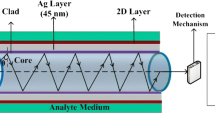Abstract
A recently published plasmonic biosensor based on birefringent solid-core microstructured optical fiber is applied for detection of five types of human-liver tissues (normal N, metastatic MET, non-cancerous metastatic (NMET), hepatocellular carcinoma (HCC), and non-cancerous hepatocellular carcinoma (NHCC)). The birefringent behavior is obtained by removing five central air holes of a two-ring hexagonal lattice of holes in a gold covered silica fiber with the liver layer surrounding the fiber. The loss spectra show two resonant peaks corresponding to the phase matching points. To distinguish between normal and malignant liver tissues, we compare the relevant parameter for the type I and II core modes. Thus, for a decrease of the real part of the refractive index from 1.373431 (human-liver N) to 1.354602 (human-liver MET), the resonance spectral width δλ 0.5 is increased from 44.3 to 54.2 nm for the core mode II. In addition, the amplitude sensitivity S A is decreased from 158.6 to 88.4 RIU−1 for the same core mode. The advantages of another recently proposed plasmonic sensor based on a Bragg fiber are the larger values of the transmission loss, maximum value of the amplitude sensitivity, figure of merit, power fraction in a normal liver layer, and power fraction in the gold layer as compared with that for a microstructured fiber when applied for detection of a normal liver tissue. Another advantage of the Bragg fiber is related to the smaller value of the difference between maximal amplitude sensitivity and resonant wavelengths.







Similar content being viewed by others
References
Giannios P, Toutouzas KG, Matiatou M, Stasinos K, Konstadoulakis MM, Zografos GC, Moutzouris K (2016) Visible to near-infrared refractive properties of freshly-excised human-liver tissues: marking hepatic malignancies. Sci Rep 6:27910. doi:10.1038/srep27910
Wang Y, Luo Z, Liu K, Wang J, Duan Y (2016) In situ targeting TEM8 via immune response and polypeptide recognition by wavelengthmodulated surface plasmon resonance biosensor. Sci Rep 6:20006. doi:10.1038/srep20006
Popescu VA, Puscas NN, Perrone G (2012) Power absorption efficiency of a new microstructured plasmon optical fiber. J Opt Soc Am B 29(11):3039–3046. doi:10.1364/JOSAB.29.003039
Popescu VA, Puscas NN, Perrone G (2014) Strong power absorption in a new microstructured holey fiber-based plasmonic sensor. J. Opt. Soc. Am. B 31(5):1062–1070. doi:10.1364/JOSAB.31.001062
Popescu VA, Puscas NN, Perrone G (2016) Simulation of the sensing performance of a plasmonic biosensor based on birefringent solid-core microstructured optical fiber. Plasmonics . doi:10.1007/s11468-016-0342-yPublished online: 08 August 2016
Popescu VA (2016) Application of a plasmonic biosensor for detection of human blood groups. Plasmonics 10.1007/s11468-016-0440-xPublished online: 22 November 2016
Popescu VA, Puscas NN, Perrone G (2016) Sensing performance of the Bragg fiber-based plasmonic sensors with four layers. Plasmonics 11(4):1183–1189. doi:10.1007/s11468-015-0158-1
Sharma AK, Rajan R, Gupta BD (2007) Influence of dopants on the performance of a fiber optic surface plasmon resonance sensor. Opt Commun 274(2):320–326
Verma RK, Sharma AK, Gupta BD (2008) Surface plasmon resonance based tapered fiber optic sensor with different taper profiles. Opt Commun 281:1486–1491
Ghatak AK, Thyagarajan K (1999) Introduction to fiber optics. Cambridge University Press, Cambridge
Madarasz FL, Dimmock JO, Dietz N, Bachmann KL (2000) Sellmeier parameters for ZnGaP2 and GaP. J Appl Phys 87(3):1564–1565. doi:10.1063/1.372050
Vial A, Grimault AS, Macías D, Barchiesi D, Chapelle ML (2005) Improved analytical fit of gold dispersion: Application to the modeling of extinction spectra with a finite-difference time-domain method. Phys Rev B 71:085416. doi:10.1103/PhysRevB.71.085416
Shalabney A, Abdulhalim I (2012) Figure-of-merit enhancement of surface plasmon resonance sensors in the spectral interrogation. Opt Lett 37(7):1175–1177. doi:10.1364/OL.37.001175
Popescu VA, Puscas NN, Perrone G (2016) Application of a new vector mode solver to optical fiber based plasmonic sensors. Mod Phys Lett B 30(7):1650075. doi:10.1142/S0217984916500755
Popescu VA, Puscas NN (2015) Propagation characteristic in a new photonic fiber based plasmonic sensor. Rom Rep Phys 67(2):500–507 http://www.rrp.infim.ro/2015_67_2/A20.pdf
Popescu VA, Puscas NN, Perrone G ((2015)) Efficient light absorption in a new Bragg fiber-based plasmonic sensor. J Opt Soc Am B 32(3):473–478 (2015). doi:10.1364/JOSAB.32.000473
Author information
Authors and Affiliations
Corresponding author
Rights and permissions
About this article
Cite this article
Popescu, V.A. Application of a Plasmonic Biosensor for Detection of Human-Liver Tissues. Plasmonics 13, 575–582 (2018). https://doi.org/10.1007/s11468-017-0546-9
Received:
Accepted:
Published:
Issue Date:
DOI: https://doi.org/10.1007/s11468-017-0546-9




